 Evacuees
wait to board a military aircraft in Leyte, Philippines, on Tuesday, November
12. Typhoon Haiyan, one of the strongest storms in recorded history, laid waste
to the Philippines. President Benigno Aquino III said as many as 2,500 people
may have been killed by the storm.
Evacuees
wait to board a military aircraft in Leyte, Philippines, on Tuesday, November
12. Typhoon Haiyan, one of the strongest storms in recorded history, laid waste
to the Philippines. President Benigno Aquino III said as many as 2,500 people
may have been killed by the storm.
 Police
line up bodies for processing in Tacloban, Philippines, on November 12.
Police
line up bodies for processing in Tacloban, Philippines, on November 12.
 People
walk through damage in Tacloban on November 12.
People
walk through damage in Tacloban on November 12.
 A young
man waits at the airport November 12 in hopes of being evacuated from
Tacloban.
A young
man waits at the airport November 12 in hopes of being evacuated from
Tacloban.
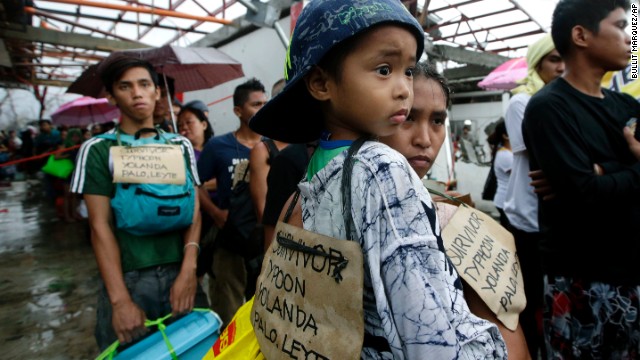 Survivors
wait to board a military plane November 12 in Tacloban.
Survivors
wait to board a military plane November 12 in Tacloban.
 A woman
comforts a crying relative as a plane leaves the Tacloban airport November
12.
A woman
comforts a crying relative as a plane leaves the Tacloban airport November
12.
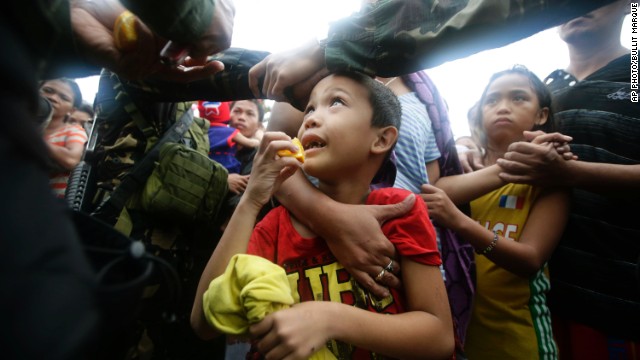 A
Philippines air force officer hands out orange slices to typhoon survivors as
they line up to board a military plane November 12 in Tacloban.
A
Philippines air force officer hands out orange slices to typhoon survivors as
they line up to board a military plane November 12 in Tacloban.
 A man
sits crying on a packed aircraft in Tacloban on November 12.
A man
sits crying on a packed aircraft in Tacloban on November 12.
 Debris
lays scattered around a damaged home near the Tacloban airport on November
12.
Debris
lays scattered around a damaged home near the Tacloban airport on November
12.
 A young
man washes his dog November 12 in Tacloban.
A young
man washes his dog November 12 in Tacloban.
 A girl
sits inside a bus as she waits for a ferry in Matnog, Philippines, on November
12.
A girl
sits inside a bus as she waits for a ferry in Matnog, Philippines, on November
12.
 Residents carry bags of rice from a Tacloban warehouse
that they stormed November 11 because of a food shortage.
Residents carry bags of rice from a Tacloban warehouse
that they stormed November 11 because of a food shortage.
 Survivors in Tacloban board a military plane bound for the
Philippine capital of Manila on November 11.
Survivors in Tacloban board a military plane bound for the
Philippine capital of Manila on November 11.
 People
in Tacloban pass debris on November 11.
People
in Tacloban pass debris on November 11.
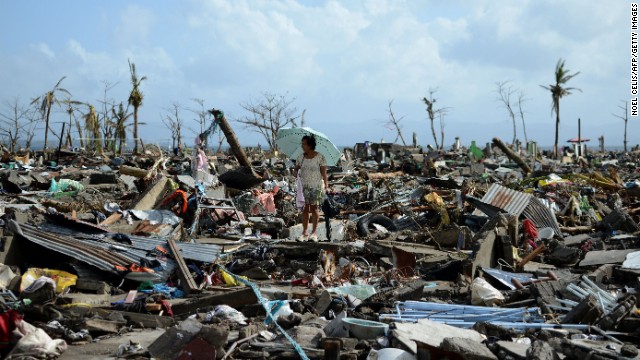 A woman
in Tacloban walks amid the debris of destroyed houses on November 11.
A woman
in Tacloban walks amid the debris of destroyed houses on November 11.
 People
make their way across a flooded street in Shangsi, China, on November 11. Haiyan
moved toward Vietnam and south China after devastating the Philippines.
People
make their way across a flooded street in Shangsi, China, on November 11. Haiyan
moved toward Vietnam and south China after devastating the Philippines.
 Buildings lie in ruins on Eastern Samar's Victory
Island.
Buildings lie in ruins on Eastern Samar's Victory
Island.
 Emily
Ortega rests on November 11 after giving birth to Bea Joy at an improvised
clinic at the Tacloban airport.
Emily
Ortega rests on November 11 after giving birth to Bea Joy at an improvised
clinic at the Tacloban airport.
 U.S.
Marine Corps Osprey aircraft arrive at Manila's Villamor Airbase to deliver
humanitarian aid on November 11.
U.S.
Marine Corps Osprey aircraft arrive at Manila's Villamor Airbase to deliver
humanitarian aid on November 11.
 People
ride past destruction in Tacloban on Sunday, November 10.
People
ride past destruction in Tacloban on Sunday, November 10.
 A body
lies amid the Tacloban devastation on November 10.
A body
lies amid the Tacloban devastation on November 10.
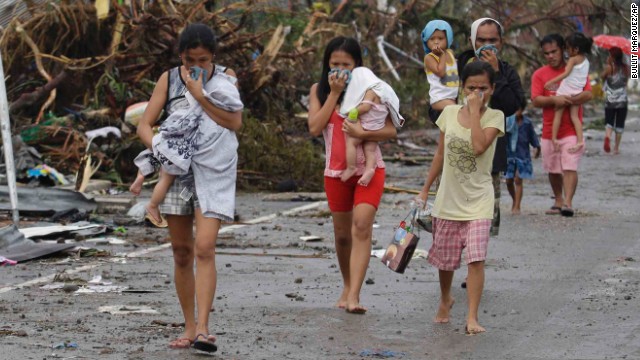 People
cover their noses to block the smell of bodies in Tacloban on November
10.
People
cover their noses to block the smell of bodies in Tacloban on November
10.
 Bodies
of victims lie along a Tacloban road on November 10.
Bodies
of victims lie along a Tacloban road on November 10.
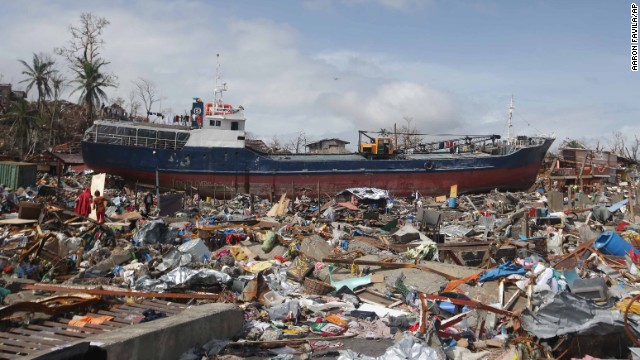 A large
boat sits aground, surrounded by debris in Tacloban on November 10.
A large
boat sits aground, surrounded by debris in Tacloban on November 10.
 People
walk past the Tacloban devastation on November 10.
People
walk past the Tacloban devastation on November 10.
 People
stand under a shelter in Tacloban.
People
stand under a shelter in Tacloban.
 Clothes
dry on a line November 10 outside a Tacloban stadium used as an evacuation
center.
Clothes
dry on a line November 10 outside a Tacloban stadium used as an evacuation
center.
 A girl
peeks out from a makeshift shelter in Tacloban.
A girl
peeks out from a makeshift shelter in Tacloban.
 Typhoon
survivors wait to receive relief goods at the Tacloban airport on November
10.
Typhoon
survivors wait to receive relief goods at the Tacloban airport on November
10.
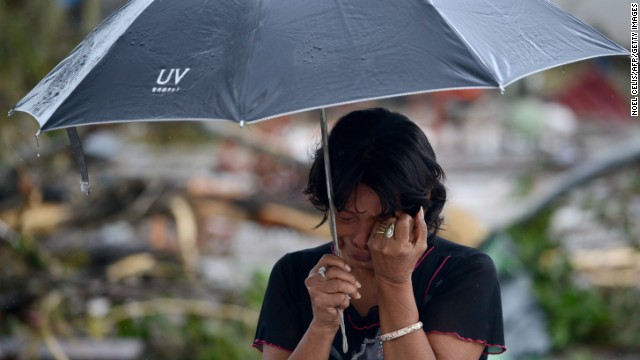 A woman
mourns in front of her husband's dead body November 10 in Tacloban.
A woman
mourns in front of her husband's dead body November 10 in Tacloban.
 Fallen
trees litter the ground at the Tacloban airport on Saturday, November 9.
Fallen
trees litter the ground at the Tacloban airport on Saturday, November 9.
 A
resident passes victims' bodies on a Tacloban street November 9.
A
resident passes victims' bodies on a Tacloban street November 9.
 People
in Tacloban carry a victim of the typhoon November 9.
People
in Tacloban carry a victim of the typhoon November 9.
 A
vehicle lies amid Tacloban debris on November 9.
A
vehicle lies amid Tacloban debris on November 9.
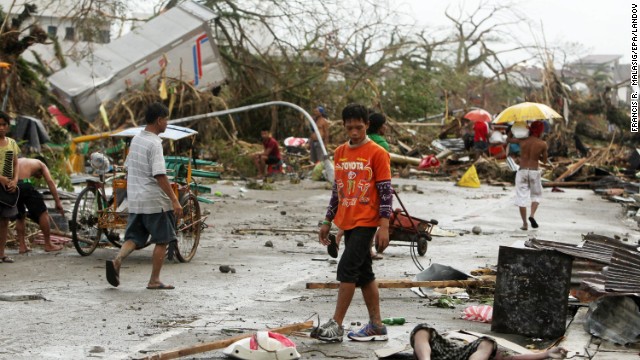 People
walk past a victim left on the side of a road in Tacloban.
People
walk past a victim left on the side of a road in Tacloban.
 A
resident passes an overturned car in Tacloban on November 9.
A
resident passes an overturned car in Tacloban on November 9.
 Rescue
workers carry a woman about to give birth November 9 at a makeshift medical
center at the Tacloban airport.
Rescue
workers carry a woman about to give birth November 9 at a makeshift medical
center at the Tacloban airport.
 An
airport lies in ruins in Tacloban.
An
airport lies in ruins in Tacloban.
 Astronaut Karen L. Nyberg took a picture of the typhoon
from the International Space Station on November 9.
Astronaut Karen L. Nyberg took a picture of the typhoon
from the International Space Station on November 9.
 Women
walk past fallen trees and destroyed houses in Tacloban on November 9. Residents
scoured supermarkets for water and food as they slowly emerged on streets
littered with debris.
Women
walk past fallen trees and destroyed houses in Tacloban on November 9. Residents
scoured supermarkets for water and food as they slowly emerged on streets
littered with debris.
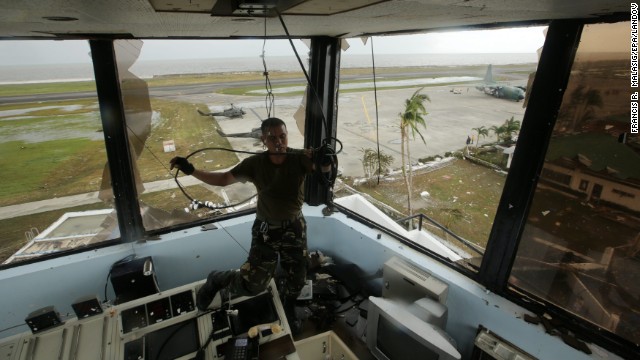 A
soldier pulls a cable inside the devastated airport tower in Tacloban.
A
soldier pulls a cable inside the devastated airport tower in Tacloban.
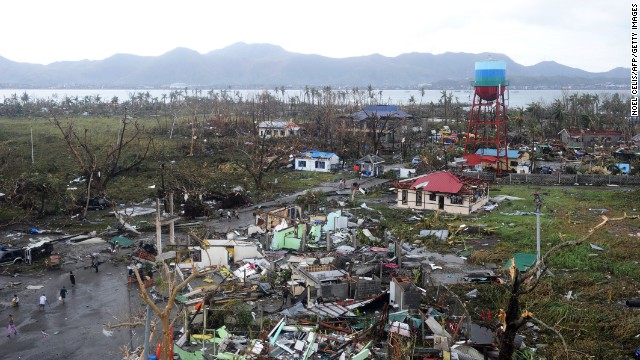 Tacloban
houses are destroyed by the strong winds caused by the typhoon.
Tacloban
houses are destroyed by the strong winds caused by the typhoon.
 Dark
clouds brought by Haiyan loom over Manila skyscrapers on November 8.
Dark
clouds brought by Haiyan loom over Manila skyscrapers on November 8.
 A woman
carries a baby across a river November 8 at a coastal village in Las Pinas,
Philippines.
A woman
carries a baby across a river November 8 at a coastal village in Las Pinas,
Philippines.
 A
resident walks along a fishing village in Bacoor, Philippines, on November
8.
A
resident walks along a fishing village in Bacoor, Philippines, on November
8.
 A house
in Legazpi, Philippines, is engulfed by storm surge November 8.
A house
in Legazpi, Philippines, is engulfed by storm surge November 8.
 A child
wraps himself in a blanket inside a makeshift house along a Bacoor fishing
village.
A child
wraps himself in a blanket inside a makeshift house along a Bacoor fishing
village.
 A woman
and her children head for an evacuation center November 8 amid strong winds in
Cebu City, Philippines.
A woman
and her children head for an evacuation center November 8 amid strong winds in
Cebu City, Philippines.
 Huge
waves from Haiyan hit the shoreline in Legazpi on November 8.
Huge
waves from Haiyan hit the shoreline in Legazpi on November 8.
 A
fisherman lifts a post to reinforce his home at a coastal village in Las Pinas
on November 8.
A
fisherman lifts a post to reinforce his home at a coastal village in Las Pinas
on November 8.
 A
resident unloads nets off a fishing boat in Bacoor on November 8.
A
resident unloads nets off a fishing boat in Bacoor on November 8.
 Residents clear a road November 8 after a tree was toppled
by strong winds in the Philippine province of Cebu.
Residents clear a road November 8 after a tree was toppled
by strong winds in the Philippine province of Cebu.
 A
fisherman secures his wooden boat November 8 as Haiyan's strong winds hit
Legazpi.
A
fisherman secures his wooden boat November 8 as Haiyan's strong winds hit
Legazpi.
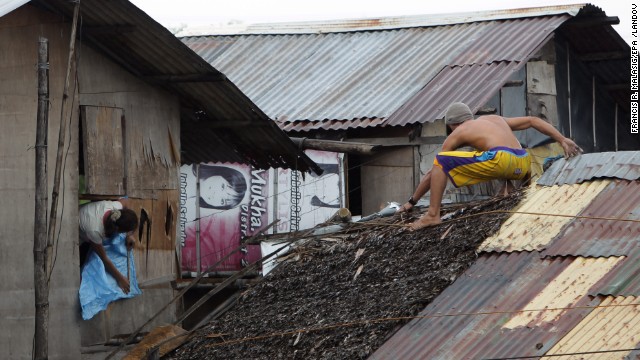 Residents reinforce their homes in Las Pinas on November
8.
Residents reinforce their homes in Las Pinas on November
8.
 Legazpi
residents are relocated to an evacuation center on Thursday, November 7. About
125,000 people took refuge in evacuation centers, and hundreds of flights were
canceled.
Legazpi
residents are relocated to an evacuation center on Thursday, November 7. About
125,000 people took refuge in evacuation centers, and hundreds of flights were
canceled.
 The
storm approaches the Philippines in this satellite image taken November 7 by the
National Oceanic and Atmospheric Administration.
The
storm approaches the Philippines in this satellite image taken November 7 by the
National Oceanic and Atmospheric Administration.
 Workers
bring down a billboard in Makati, Philippines, on November 7 before Haiyan makes
landfall.
Workers
bring down a billboard in Makati, Philippines, on November 7 before Haiyan makes
landfall.
 Philippine Coast Guard personnel stand in formation beside
newly acquired rubber boats after a blessing ceremony in Manila on Wednesday,
November 6. The boats were to be deployed to the central Philippines in
preparation for Haiya
Philippine Coast Guard personnel stand in formation beside
newly acquired rubber boats after a blessing ceremony in Manila on Wednesday,
November 6. The boats were to be deployed to the central Philippines in
preparation for Haiya Situated where the Philippines meets the Pacific
Ocean, Guiuan had the look and feel of a tropical paradise -- replete with surf
camps, resorts and pristine white beaches. Its location on Samar Island's
southeastern tip, in many ways, had been Guiuan's greatest blessing.
And now? It could be seen as its
greatest curse.
When Super Typhoon Haiyan came
ashore early Friday -- bringing sustained winds of 315 kph (195 mph) and gusts
as strong as 380 kph (235 mph) -- it did so in Guiuan.
Typhoon damage from the
air
Family goes through ceiling to
flee storm
Buildings collapsed, palm trees
snapped, shelters ceased to be. And with devastation came desperate needs for,
as one Guiuan put it, "food, tents, everything."
As he noted: "Everything is
gone."
Guiuan was cut off from outside
communication and many basic necessities until recently, when a C-130 military
cargo plane flew over the ravaged area and landed at its small airport.
The aircraft's cargo bay was
packed with supplies and Filipino troops.
Once there, where should they
start to help? That's hard to say, admits Guiuan Mayor Christopher Gonzales,
given the scale of what's happened. Almost all of his community's 50,000 people
are now homeless, thanks to Haiyan.
"If you want to look at our
municipality," Gonzales said, "it's total damage; 100% damage."
The troops don't waste any time,
quickly unloading drinking water and bags of rice, as residents watch from a
safe distance. Some troops stay to participate in search-and-rescue operations
in a place where the death toll is still far from settled.
Within 20 minutes, the C-130 is
back buzzing again. Its new load includes some people hurt by the storm, some
with spinal injuries. Other more able-bodied people have found seats, hoping to
get far from the misery that is likely to forever be associated with a place
that many had considered paradise
cnn.com.


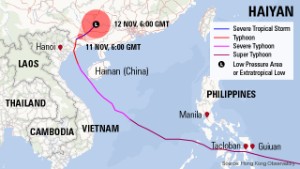
 Evacuees
wait to board a military aircraft in Leyte, Philippines, on Tuesday, November
12. Typhoon Haiyan, one of the strongest storms in recorded history, laid waste
to the Philippines. President Benigno Aquino III said as many as 2,500 people
may have been killed by the storm.
Evacuees
wait to board a military aircraft in Leyte, Philippines, on Tuesday, November
12. Typhoon Haiyan, one of the strongest storms in recorded history, laid waste
to the Philippines. President Benigno Aquino III said as many as 2,500 people
may have been killed by the storm.

 Police
line up bodies for processing in Tacloban, Philippines, on November 12.
Police
line up bodies for processing in Tacloban, Philippines, on November 12.
 People
walk through damage in Tacloban on November 12.
People
walk through damage in Tacloban on November 12.
 A young
man waits at the airport November 12 in hopes of being evacuated from
Tacloban.
A young
man waits at the airport November 12 in hopes of being evacuated from
Tacloban.
 Survivors
wait to board a military plane November 12 in Tacloban.
Survivors
wait to board a military plane November 12 in Tacloban.
 A woman
comforts a crying relative as a plane leaves the Tacloban airport November
12.
A woman
comforts a crying relative as a plane leaves the Tacloban airport November
12.
 A
Philippines air force officer hands out orange slices to typhoon survivors as
they line up to board a military plane November 12 in Tacloban.
A
Philippines air force officer hands out orange slices to typhoon survivors as
they line up to board a military plane November 12 in Tacloban.
 A man
sits crying on a packed aircraft in Tacloban on November 12.
A man
sits crying on a packed aircraft in Tacloban on November 12.
 Debris
lays scattered around a damaged home near the Tacloban airport on November
12.
Debris
lays scattered around a damaged home near the Tacloban airport on November
12.
 A young
man washes his dog November 12 in Tacloban.
A young
man washes his dog November 12 in Tacloban.
 A girl
sits inside a bus as she waits for a ferry in Matnog, Philippines, on November
12.
A girl
sits inside a bus as she waits for a ferry in Matnog, Philippines, on November
12.
 Residents carry bags of rice from a Tacloban warehouse
that they stormed November 11 because of a food shortage.
Residents carry bags of rice from a Tacloban warehouse
that they stormed November 11 because of a food shortage.
 Survivors in Tacloban board a military plane bound for the
Philippine capital of Manila on November 11.
Survivors in Tacloban board a military plane bound for the
Philippine capital of Manila on November 11.
 People
in Tacloban pass debris on November 11.
People
in Tacloban pass debris on November 11.
 A woman
in Tacloban walks amid the debris of destroyed houses on November 11.
A woman
in Tacloban walks amid the debris of destroyed houses on November 11.
 People
make their way across a flooded street in Shangsi, China, on November 11. Haiyan
moved toward Vietnam and south China after devastating the Philippines.
People
make their way across a flooded street in Shangsi, China, on November 11. Haiyan
moved toward Vietnam and south China after devastating the Philippines.
 Buildings lie in ruins on Eastern Samar's Victory
Island.
Buildings lie in ruins on Eastern Samar's Victory
Island.
 Emily
Ortega rests on November 11 after giving birth to Bea Joy at an improvised
clinic at the Tacloban airport.
Emily
Ortega rests on November 11 after giving birth to Bea Joy at an improvised
clinic at the Tacloban airport.
 U.S.
Marine Corps Osprey aircraft arrive at Manila's Villamor Airbase to deliver
humanitarian aid on November 11.
U.S.
Marine Corps Osprey aircraft arrive at Manila's Villamor Airbase to deliver
humanitarian aid on November 11.
 People
ride past destruction in Tacloban on Sunday, November 10.
People
ride past destruction in Tacloban on Sunday, November 10.
 A body
lies amid the Tacloban devastation on November 10.
A body
lies amid the Tacloban devastation on November 10.
 People
cover their noses to block the smell of bodies in Tacloban on November
10.
People
cover their noses to block the smell of bodies in Tacloban on November
10.
 Bodies
of victims lie along a Tacloban road on November 10.
Bodies
of victims lie along a Tacloban road on November 10.
 A large
boat sits aground, surrounded by debris in Tacloban on November 10.
A large
boat sits aground, surrounded by debris in Tacloban on November 10.
 People
walk past the Tacloban devastation on November 10.
People
walk past the Tacloban devastation on November 10.
 People
stand under a shelter in Tacloban.
People
stand under a shelter in Tacloban.
 Clothes
dry on a line November 10 outside a Tacloban stadium used as an evacuation
center.
Clothes
dry on a line November 10 outside a Tacloban stadium used as an evacuation
center.
 A girl
peeks out from a makeshift shelter in Tacloban.
A girl
peeks out from a makeshift shelter in Tacloban.
 Typhoon
survivors wait to receive relief goods at the Tacloban airport on November
10.
Typhoon
survivors wait to receive relief goods at the Tacloban airport on November
10.
 A woman
mourns in front of her husband's dead body November 10 in Tacloban.
A woman
mourns in front of her husband's dead body November 10 in Tacloban.
 Fallen
trees litter the ground at the Tacloban airport on Saturday, November 9.
Fallen
trees litter the ground at the Tacloban airport on Saturday, November 9.
 A
resident passes victims' bodies on a Tacloban street November 9.
A
resident passes victims' bodies on a Tacloban street November 9.
 People
in Tacloban carry a victim of the typhoon November 9.
People
in Tacloban carry a victim of the typhoon November 9.
 A
vehicle lies amid Tacloban debris on November 9.
A
vehicle lies amid Tacloban debris on November 9.
 People
walk past a victim left on the side of a road in Tacloban.
People
walk past a victim left on the side of a road in Tacloban.
 A
resident passes an overturned car in Tacloban on November 9.
A
resident passes an overturned car in Tacloban on November 9.
 Rescue
workers carry a woman about to give birth November 9 at a makeshift medical
center at the Tacloban airport.
Rescue
workers carry a woman about to give birth November 9 at a makeshift medical
center at the Tacloban airport.
 An
airport lies in ruins in Tacloban.
An
airport lies in ruins in Tacloban.
 Astronaut Karen L. Nyberg took a picture of the typhoon
from the International Space Station on November 9.
Astronaut Karen L. Nyberg took a picture of the typhoon
from the International Space Station on November 9.
 Women
walk past fallen trees and destroyed houses in Tacloban on November 9. Residents
scoured supermarkets for water and food as they slowly emerged on streets
littered with debris.
Women
walk past fallen trees and destroyed houses in Tacloban on November 9. Residents
scoured supermarkets for water and food as they slowly emerged on streets
littered with debris.
 A
soldier pulls a cable inside the devastated airport tower in Tacloban.
A
soldier pulls a cable inside the devastated airport tower in Tacloban.
 Tacloban
houses are destroyed by the strong winds caused by the typhoon.
Tacloban
houses are destroyed by the strong winds caused by the typhoon.
 Dark
clouds brought by Haiyan loom over Manila skyscrapers on November 8.
Dark
clouds brought by Haiyan loom over Manila skyscrapers on November 8.
 A woman
carries a baby across a river November 8 at a coastal village in Las Pinas,
Philippines.
A woman
carries a baby across a river November 8 at a coastal village in Las Pinas,
Philippines.
 A
resident walks along a fishing village in Bacoor, Philippines, on November
8.
A
resident walks along a fishing village in Bacoor, Philippines, on November
8.
 A house
in Legazpi, Philippines, is engulfed by storm surge November 8.
A house
in Legazpi, Philippines, is engulfed by storm surge November 8.
 A child
wraps himself in a blanket inside a makeshift house along a Bacoor fishing
village.
A child
wraps himself in a blanket inside a makeshift house along a Bacoor fishing
village.
 A woman
and her children head for an evacuation center November 8 amid strong winds in
Cebu City, Philippines.
A woman
and her children head for an evacuation center November 8 amid strong winds in
Cebu City, Philippines.
 Huge
waves from Haiyan hit the shoreline in Legazpi on November 8.
Huge
waves from Haiyan hit the shoreline in Legazpi on November 8.
 A
fisherman lifts a post to reinforce his home at a coastal village in Las Pinas
on November 8.
A
fisherman lifts a post to reinforce his home at a coastal village in Las Pinas
on November 8.
 A
resident unloads nets off a fishing boat in Bacoor on November 8.
A
resident unloads nets off a fishing boat in Bacoor on November 8.
 Residents clear a road November 8 after a tree was toppled
by strong winds in the Philippine province of Cebu.
Residents clear a road November 8 after a tree was toppled
by strong winds in the Philippine province of Cebu.
 A
fisherman secures his wooden boat November 8 as Haiyan's strong winds hit
Legazpi.
A
fisherman secures his wooden boat November 8 as Haiyan's strong winds hit
Legazpi.
 Residents reinforce their homes in Las Pinas on November
8.
Residents reinforce their homes in Las Pinas on November
8.
 Legazpi
residents are relocated to an evacuation center on Thursday, November 7. About
125,000 people took refuge in evacuation centers, and hundreds of flights were
canceled.
Legazpi
residents are relocated to an evacuation center on Thursday, November 7. About
125,000 people took refuge in evacuation centers, and hundreds of flights were
canceled.
 The
storm approaches the Philippines in this satellite image taken November 7 by the
National Oceanic and Atmospheric Administration.
The
storm approaches the Philippines in this satellite image taken November 7 by the
National Oceanic and Atmospheric Administration.
 Workers
bring down a billboard in Makati, Philippines, on November 7 before Haiyan makes
landfall.
Workers
bring down a billboard in Makati, Philippines, on November 7 before Haiyan makes
landfall.
 Philippine Coast Guard personnel stand in formation beside
newly acquired rubber boats after a blessing ceremony in Manila on Wednesday,
November 6. The boats were to be deployed to the central Philippines in
preparation for Haiya Situated where the Philippines meets the Pacific
Ocean, Guiuan had the look and feel of a tropical paradise -- replete with surf
camps, resorts and pristine white beaches. Its location on Samar Island's
southeastern tip, in many ways, had been Guiuan's greatest blessing.
Philippine Coast Guard personnel stand in formation beside
newly acquired rubber boats after a blessing ceremony in Manila on Wednesday,
November 6. The boats were to be deployed to the central Philippines in
preparation for Haiya Situated where the Philippines meets the Pacific
Ocean, Guiuan had the look and feel of a tropical paradise -- replete with surf
camps, resorts and pristine white beaches. Its location on Samar Island's
southeastern tip, in many ways, had been Guiuan's greatest blessing.
No comments:
Post a Comment